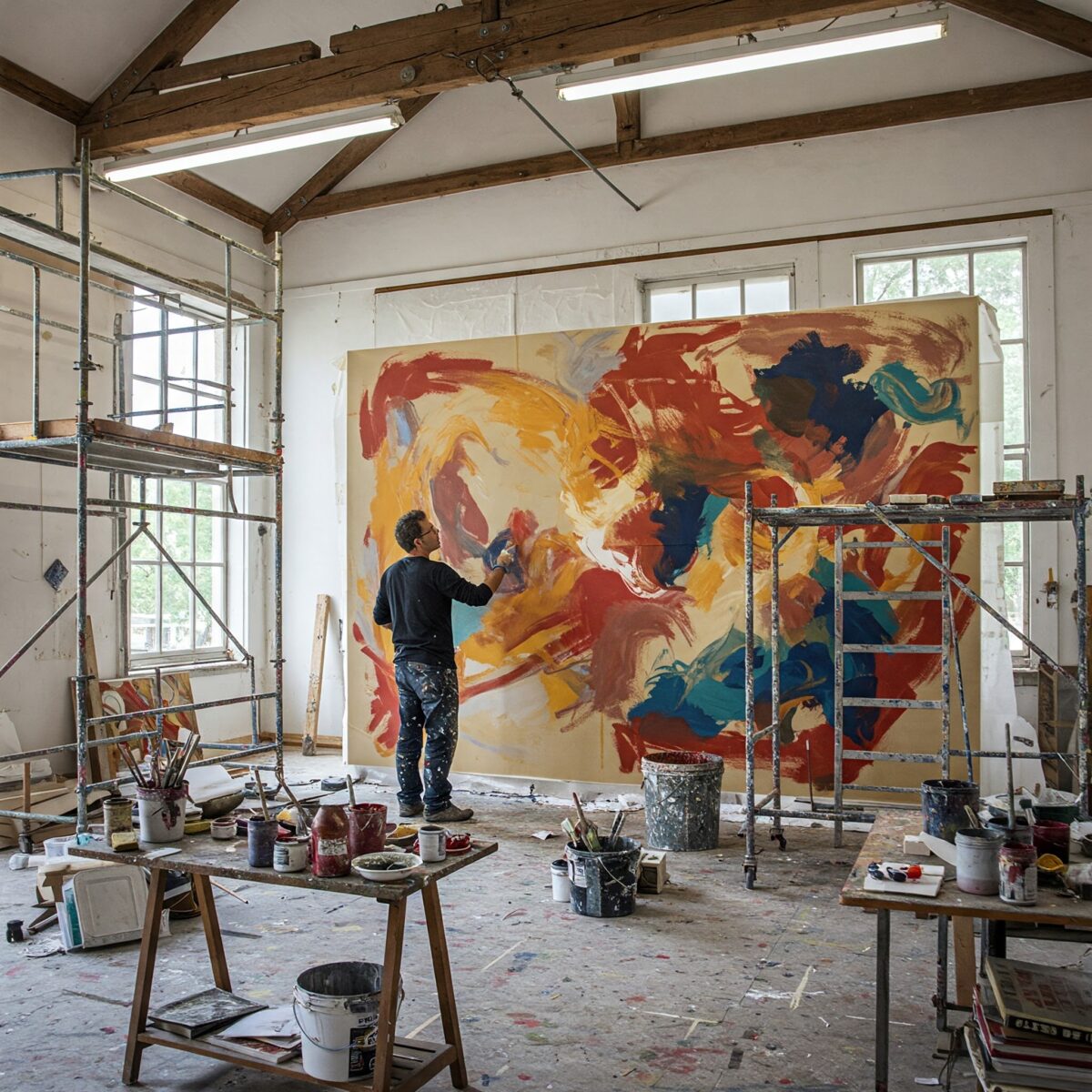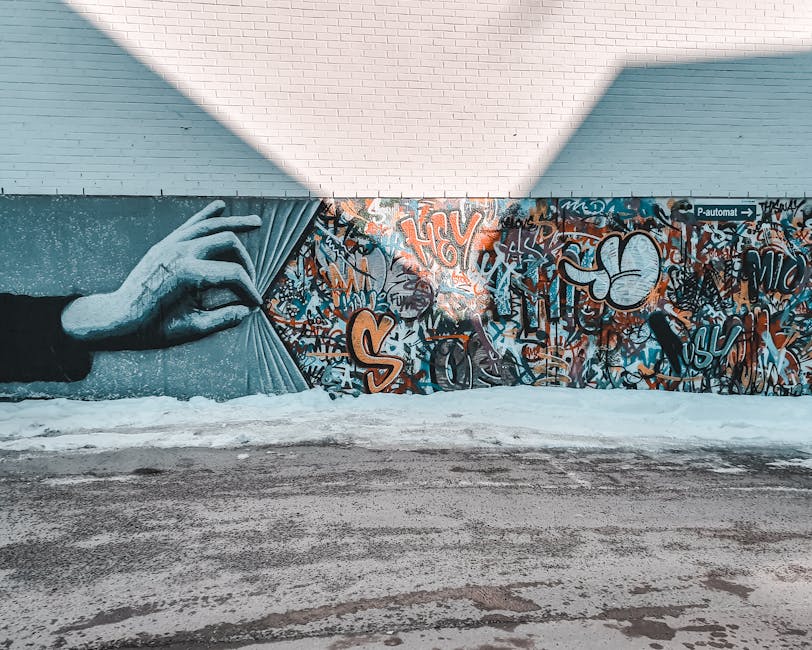For centuries, artists have sought permanence, a way to make their work last for generations. One of the most enduring answers to this quest is the art of fresco painting, a masterful technique of painting directly onto plaster. But what is a fresco, and how did artists like Michelangelo use it to create some of the world’s most iconic masterpieces?
Key Points:
- Fresco painting involves applying pigments to wet plaster, creating a chemical bond
- Two main types: buon fresco (true fresco) and fresco secco (dry fresco)
- The technique reached its peak during the Italian Renaissance
- Creating frescoes requires specialized materials, tools, and techniques
- Many ancient fresco works have survived for centuries or even millennia
- Contemporary artists continue to explore and reinvent fresco methods
What Is Fresco Painting?

Fresco painting is a mural technique where artists apply water-based pigments to freshly laid lime plaster. The word “fresco” comes from the Italian word for “fresh,” referring to the damp plaster that must be painted on while still wet. As the plaster dries, a chemical reaction occurs that binds the pigment to the wall, creating a remarkably durable surface that can withstand centuries of exposure.
There are two main types of fresco techniques:
- Buon fresco (true fresco): Pigments mixed only with water are applied to wet plaster, becoming chemically bonded to the wall as it dries.
- Fresco secco (dry fresco): Paints are applied to dry plaster, often with a binding agent like egg or glue to make them stick.
Of the two methods, buon fresco creates more durable artwork but requires greater skill and timing.
Ancient Origins
Fresco painting is among the oldest painting techniques in human history. Early examples have been found in:
- Ancient Egypt: Tomb paintings dating back to 3000 BCE
- Minoan Civilization: The vibrant frescoes at Knossos in Crete (1700-1400 BCE)
- Ancient Rome: The remarkably preserved works at Pompeii and Herculaneum
- Byzantine Empire: Religious frescoes in churches throughout the Eastern Mediterranean
The ancient Roman frescoes discovered at Pompeii reveal sophisticated artistic techniques that would not be matched again until the Renaissance. These works were preserved when Mount Vesuvius erupted in 79 CE, burying the city in ash.
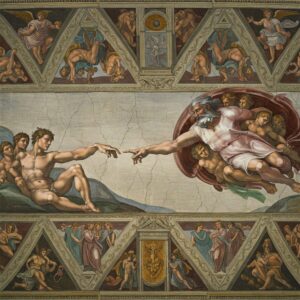
Renaissance Revival
While fresco painting never completely disappeared, it reached new heights during the Italian Renaissance (14th-16th centuries). This period saw the creation of some of the most famous fresco artworks in history:
- Giotto’s Arena Chapel in Padua (early 14th century), which revolutionized painting with its emotional expressiveness
- Masaccio’s Trinity in Florence’s Santa Maria Novella (1426-1428)
- Raphael’s magnificent frescoes in the Vatican
- Michelangelo’s breathtaking ceiling of the Sistine Chapel (1508-1512)
The Renaissance masters refined fresco techniques to new levels, solving technical problems and creating works of unprecedented scale and complexity.
“The true work of art is but a shadow of the divine perfection.”
Michelangelo, who spent four years painting the Sistine Chapel ceiling
while standing on scaffolding, his neck craned upward.
Buon Fresco vs. Fresco Secco
The term “fresco” isn’t a one-size-fits-all description. The technique is primarily divided into two distinct methods, each with its own process, advantages, and results: Buon Fresco and Fresco Secco.
Buon Fresco (“True Fresco”)
When people speak of the great, enduring frescoes of the Renaissance, they are almost always referring to buon fresco. This is the “true fresco” method, where the artist paints with pigment mixed simply with water and applies it directly onto a thin, still-wet layer of plaster, known as the intonaco.
The magic of this process lies in the chemical reaction: as the plaster cures, the pigment is absorbed and becomes an integral, permanent part of the wall itself. This incredible durability is why works like the Sistine Chapel ceiling have survived for centuries. The challenge, however, is speed—the artist must complete their work before the plaster dries, a section at a time.
Fresco Secco (“Dry Fresco”)
In contrast, fresco secco (or “dry fresco”) involves painting on a plaster wall that has already fully dried. For this method, the pigments must be mixed with a binding agent, such as egg tempera or glue, to make them adhere to the surface, as they cannot be absorbed by the hardened wall.
The primary advantage of fresco secco is the luxury of time. Unlike the frantic pace required for buon fresco, artists could work more slowly, adding intricate details and making corrections easily. However, this convenience comes at a cost. Because the paint is merely a layer on top of the plaster rather than being part of it, it is far less durable and more susceptible to flaking and moisture damage over the centuries.
The Traditional Fresco Painting Process
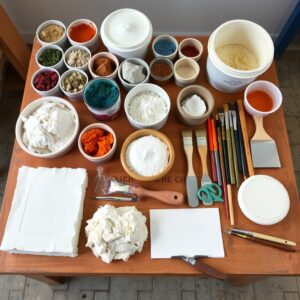
Creating a fresco is a complex undertaking that requires careful planning and swift execution. Here are the main steps in the traditional process:
1. Preparation
Before any painting begins, artists must:
- Create detailed drawings or “cartoons” of the final composition
- Prepare the wall with a rough layer of plaster called “arriccio”
- Mix lime putty with marble dust or sand to create the smooth final layer, “intonaco”
- Prepare natural pigments by grinding minerals, plants, and earth materials
2. The Giornata System
Because plaster dries quickly, artists work in sections called “giornate” (Italian for “days”). Each day, they:
- Apply fresh intonaco only to the area they can paint that day
- Transfer the design to the wet plaster by pricking holes along the lines of their cartoon and dusting with charcoal
- Mix pigments with water (no binder needed in buon fresco)
- Apply paint quickly before the plaster dries
- Blend edges carefully where sections will join
This time-sensitive process requires focus and skill—once the plaster dries, no major changes can be made without removing and replacing it.
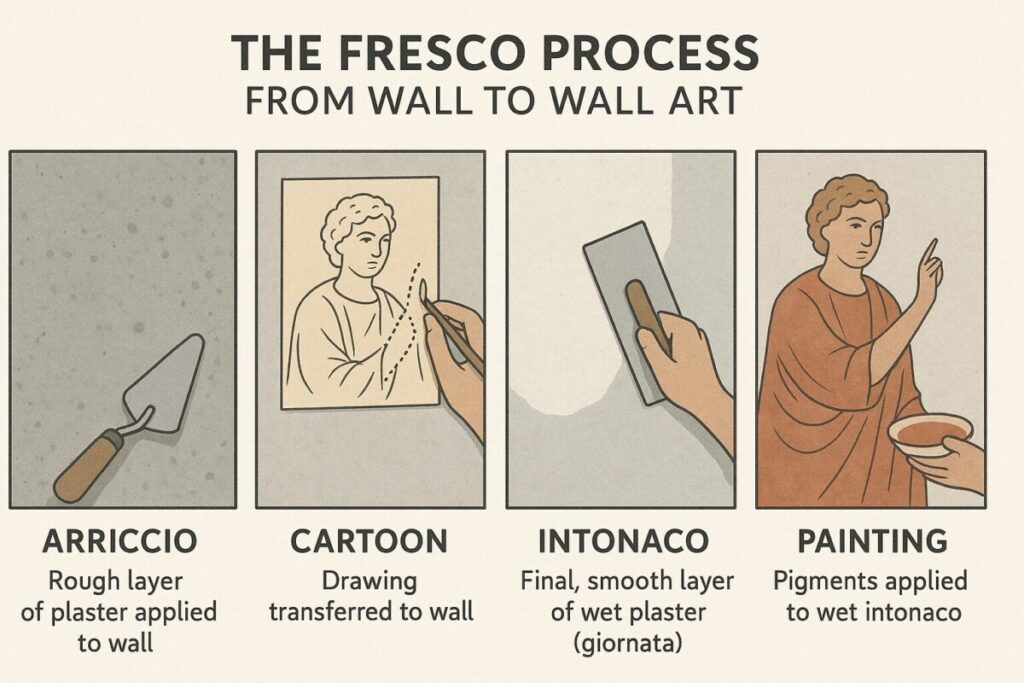
3. Limitations and Challenges
Fresco painters face unique challenges:
- Limited color palette (some pigments react badly with lime)
- No ability to correct mistakes once plaster dries
- Physical demands of working quickly, often on scaffolding
- Need to visualize how colors will change as plaster dries
These constraints have led to distinctive artistic solutions and techniques that characterize fresco artwork.
Famous Fresco Artists and Their Masterpieces
Throughout history, certain artists have distinguished themselves as masters of fresco painting:
| Artist | Time Period | Notable Fresco Works |
|---|---|---|
| Giotto | Early 14th century | Arena Chapel, Padua |
| Masaccio | Early 15th century | Brancacci Chapel, Florence |
| Fra Angelico | 15th century | San Marco Monastery, Florence |
| Botticelli | 15th century | Sistine Chapel wall frescoes |
| Raphael | Early 16th century | Stanza della Segnatura, Vatican |
| Michelangelo | 16th century | Sistine Chapel ceiling and altar wall |
| Diego Rivera | 20th century | Detroit Industry Murals |
Each of these artists contributed innovations to fresco technique while creating works that continue to inspire viewers today.
Famous Fresco Paintings Through History
The fresco technique has been used across cultures and millennia, leaving behind a legacy of breathtaking, large-scale artworks. From the palaces of ancient civilizations to the grand cathedrals of Europe and the public buildings of the modern era, here are a few of the most significant examples of fresco painting.
- Ancient Frescoes: Long before the Renaissance, the Minoan civilization on the island of Crete was decorating its palaces with vibrant frescoes. The famous frescoes from the Palace of Knossos, Crete (c. 1700-1450 BC), such as the “Bull-Leaping Fresco,” showcase a remarkable fluidity and use of color, capturing scenes of daily life, nature, and ritual in stunning detail that has survived for nearly four millennia.
- Italian Renaissance: This period is considered the golden age of fresco. Giotto’s Scrovegni Chapel (c. 1305) in Padua is a revolutionary masterpiece, where the artist used the buon fresco technique to create emotionally charged narrative scenes with a new sense of naturalism. A pinnacle of the art form is Michelangelo’s Sistine Chapel Ceiling (1508-1512) in Vatican City. This monumental work, depicting scenes from the Book of Genesis, is a testament to the artist’s genius and the enduring power of true fresco.
- Mexican Muralism: The fresco technique was powerfully revived in the 20th century by the artists of the Mexican Muralism movement. Diego Rivera championed fresco as a public art form to tell the stories of the Mexican people. His vast, intricate murals, such as those at the National Palace in Mexico City, used the ancient technique to create modern, socially conscious masterpieces that spoke directly to the working class.
Fresco Techniques in Modern Art
While traditional fresco painting declined after the Renaissance as artists turned to more flexible mediums like oil paint, the 20th century saw renewed interest in the technique. Mexican muralists like Diego Rivera, José Clemente Orozco, and David Alfaro Siqueiros revitalized fresco painting, using it to create powerful public art with social and political messages.
Today’s artists approach fresco in various ways:
- Some practice traditional techniques with exacting standards
- Others combine fresco elements with contemporary materials
- Public art programs use simplified fresco methods for community projects
- Conservators develop new methods to preserve historic frescoes
This blend of tradition and innovation keeps fresco art relevant in the contemporary art world.
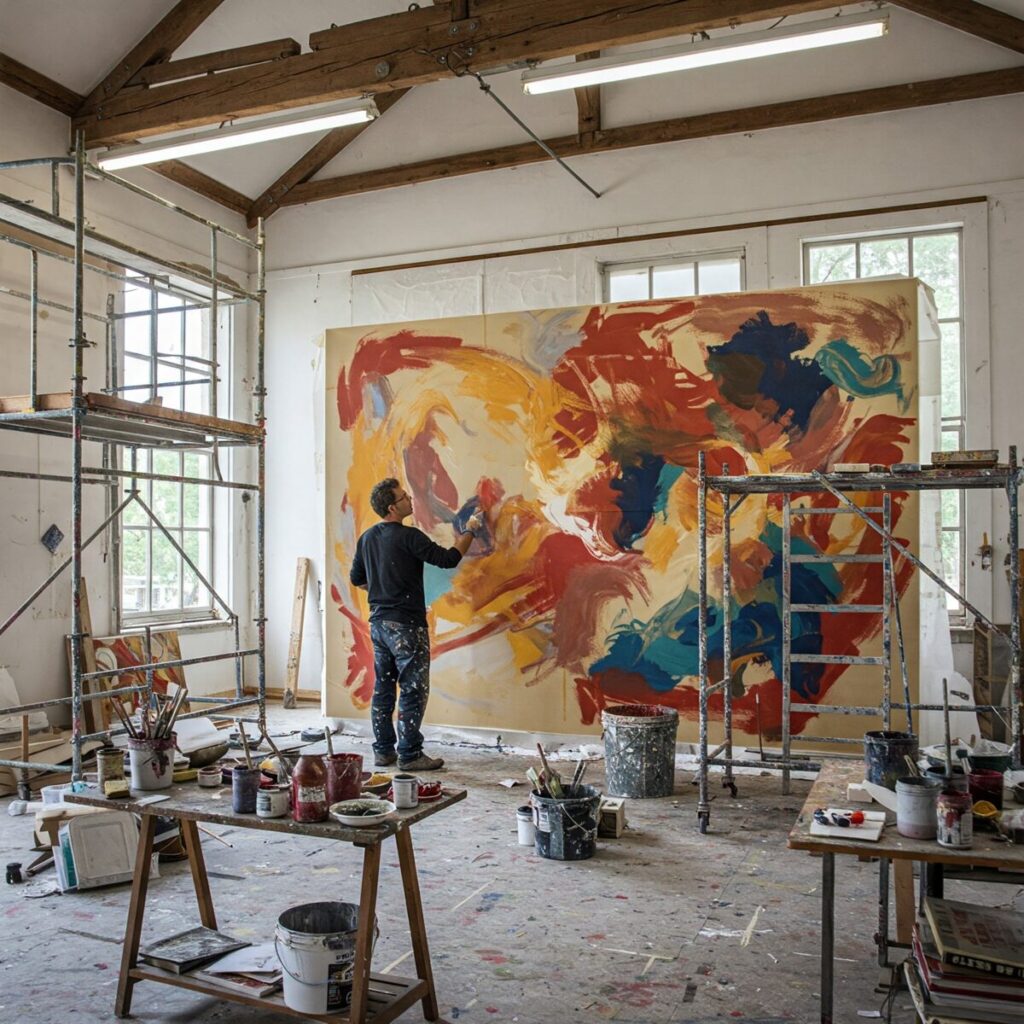
Preservation and Restoration Challenges
One of the most fascinating aspects of fresco artwork is its durability—some examples have survived for thousands of years. However, frescoes face numerous threats:
- Structural damage to buildings
- Water damage and humidity issues
- Air pollution
- Microbiological growth
- Previous improper restoration attempts
Modern conservation science has developed sophisticated techniques to preserve these treasures, including:
- Non-invasive analysis methods
- Specialized cleaning procedures
- Environmental controls
- Digital documentation
The restoration of the Sistine Chapel between 1980 and 1994 represents one of the most ambitious fresco conservation projects ever undertaken, revealing bright colors that had been hidden under centuries of soot and previous restoration attempts.
Learning from Ancient Wisdom
The durability of ancient frescoes has taught modern conservators valuable lessons about sustainable art materials. Many synthetic modern paints will not last a fraction as long as properly executed frescoes painted with simple earth pigments thousands of years ago.
Video: Fresco Painting has been around for a Long Time
Try Fresco Techniques at Home
While true fresco requires specialized materials and knowledge, you can experiment with simplified versions:
- Fresco-inspired plaster art:
- Use quick-setting plaster of Paris on a small board
- Apply watercolors or natural pigments while damp
- Experiment with textures and impressions
- Fresco secco simulation:
- Apply gesso to a surface and let dry
- Mix pigments with egg yolk (tempera) or milk glue
- Paint on the dry surface for a fresco-like appearance
These experiences can help you appreciate the challenges faced by the great fresco painters throughout history.
Conclusion
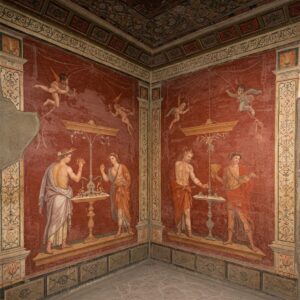
Fresco painting represents one of humanity’s most enduring artistic achievements, connecting us directly to artists who worked centuries or even millennia ago. The luminous quality of colors bonded directly to plaster creates a visual experience unlike any other painting medium. From the ancient walls of Pompeii to the soaring ceiling of the Sistine Chapel, fresco artworks continue to awe viewers with their beauty and technical mastery. As contemporary artists rediscover and reinvent this ancient technique, fresco painting remains a vibrant part of our artistic heritage—a testament to human creativity and the timeless desire to transform walls into windows of imagination.
Resources:

